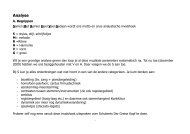Anton Webern and the influence of Heinrich Isaac
Anton Webern and the influence of Heinrich Isaac
Anton Webern and the influence of Heinrich Isaac
You also want an ePaper? Increase the reach of your titles
YUMPU automatically turns print PDFs into web optimized ePapers that Google loves.
<strong>Anton</strong> <strong>Webern</strong> <strong>and</strong> <strong>the</strong> <strong>influence</strong> <strong>of</strong> <strong>Heinrich</strong> <strong>Isaac</strong><br />
Christian Mason 2005<br />
1
<strong>Anton</strong> <strong>Webern</strong> <strong>and</strong> <strong>the</strong> <strong>influence</strong> <strong>of</strong> <strong>the</strong> <strong>Heinrich</strong> <strong>Isaac</strong><br />
Of all <strong>the</strong> members <strong>of</strong> <strong>the</strong> so-called ‘Second Viennese School’ only <strong>Anton</strong> <strong>Webern</strong><br />
can be seen to have truly superseded <strong>the</strong> aes<strong>the</strong>tics <strong>of</strong> late Romanticism. Despite<br />
leaving tonality behind, Arnold Schoenberg <strong>and</strong> Alban Berg continued to approach<br />
composition from an essentially Nineteenth-century perspective. Their concepts <strong>of</strong><br />
<strong>the</strong>matic working - based upon <strong>the</strong> ‘free development <strong>of</strong> motives characteristic <strong>of</strong> <strong>the</strong><br />
Nineteenth-century’ (Bailey, 1991: 94) – <strong>and</strong> form in particular, illustrate this, as does<br />
Schoenberg’s famous statement on twelve-note composition that “One has to follow<br />
<strong>the</strong> basic set; but, never<strong>the</strong>less, one composes as freely as before” (Schoenberg, 1975:<br />
224). Yet, though <strong>Webern</strong> did retain a certain expressionistic quality in his music,<br />
reminiscent <strong>of</strong> such composers as Mahler <strong>and</strong> Schoenberg, <strong>the</strong>re is a sense <strong>of</strong> this<br />
diminishing as his oeuvre progresses. It apparently gives way to ano<strong>the</strong>r <strong>influence</strong>, for<br />
many years latent, rooted in <strong>Webern</strong>’s doctoral dissertation study <strong>of</strong> <strong>the</strong> Renaissance<br />
composer <strong>Heinrich</strong> <strong>Isaac</strong>.<br />
The extent <strong>of</strong> <strong>Isaac</strong>’s <strong>influence</strong> on <strong>Webern</strong> has <strong>of</strong>ten been overlooked for a<br />
number <strong>of</strong> reasons, not least <strong>the</strong> efforts <strong>of</strong> <strong>the</strong> 1950’s Avant-garde to justify <strong>the</strong>ir own<br />
‘total serialism’ in terms <strong>of</strong> his work. But also because <strong>the</strong> <strong>influence</strong> <strong>of</strong> Schoenberg,<br />
not only on <strong>Webern</strong>’s musical life but also on his personal life, appears to have been<br />
particularly pr<strong>of</strong>ound, <strong>and</strong> has <strong>of</strong>ten taken precedence <strong>of</strong> interest. However, nei<strong>the</strong>r<br />
stylistically nor technically can <strong>the</strong> <strong>influence</strong> <strong>of</strong> Schoenberg, or his predecessors in <strong>the</strong><br />
‘German Tradition’, be seen as sufficient to explain <strong>the</strong> nature <strong>of</strong> <strong>Webern</strong>’s mature<br />
composition. Certain aspects <strong>of</strong> his music become much clearer however, when<br />
related to his substantial knowledge <strong>and</strong> love <strong>of</strong> <strong>the</strong> Ne<strong>the</strong>rl<strong>and</strong>ish composers such as<br />
Josquin de Prez, Pierre de la Rue, Johannes Okeghem, Jacob Obrecht, <strong>and</strong> above all<br />
<strong>Heinrich</strong> <strong>Isaac</strong>.<br />
2
It is interesting, when considering <strong>influence</strong>s upon <strong>Webern</strong>, to note that <strong>the</strong>re<br />
was a significant overlap between <strong>the</strong> preparation <strong>of</strong> his Doctorate <strong>and</strong> his studies<br />
with Schoenberg. While he was <strong>of</strong>ficially a student <strong>of</strong> Schoenberg’s from about 1904<br />
until 1908, he completed his preparation <strong>of</strong> <strong>the</strong> edition <strong>of</strong> <strong>Isaac</strong>’s Choralis<br />
Constantinus in 1906. While this doesn’t necessarily shed much light on which <strong>of</strong> <strong>the</strong><br />
two proved more pr<strong>of</strong>oundly influential, it does highlight <strong>the</strong> fact that both occurred<br />
during an artistically formative period <strong>of</strong> <strong>Webern</strong>’s life (being born in 1883, he was in<br />
his early twenties). Also noteworthy is <strong>the</strong> fact that <strong>Webern</strong>’s musicological studies<br />
under Guido Adler were, at <strong>the</strong> time, a primary concern <strong>of</strong> his; <strong>and</strong> he was just as<br />
engrossed in <strong>the</strong>m as he was in composing. Adler’s academic specialism was in <strong>the</strong><br />
area <strong>of</strong> Renaissance music. It was under his guidance that <strong>Webern</strong> prepared his<br />
edition <strong>of</strong> <strong>the</strong> second book <strong>of</strong> <strong>Isaac</strong>’s monumental Choralis Constantinus – a setting<br />
<strong>of</strong> <strong>the</strong> Mass Propers <strong>of</strong> <strong>the</strong> entire ecclesiastical year, <strong>and</strong> a ‘summa <strong>of</strong> Ne<strong>the</strong>rl<strong>and</strong>ish<br />
polyphony about 1500’ (Brown, 1976: 167).<br />
Though some would have it that <strong>Isaac</strong> wrote this work primarily in response to<br />
a commission from <strong>the</strong> Ca<strong>the</strong>dral Chapter at Constance in 1508 (Reese, 1954: 216), in<br />
<strong>Webern</strong>’s own perception <strong>the</strong> motivation for <strong>the</strong> task ‘should be sought not<br />
exclusively in practical necessities, but also in <strong>the</strong> deep religiousness <strong>of</strong> <strong>the</strong> master<br />
<strong>and</strong> in his love <strong>of</strong> <strong>the</strong> beauty <strong>of</strong> <strong>the</strong>se liturgical poems’ (<strong>Webern</strong>, 1958: 23). This<br />
observation indicates that <strong>Webern</strong>’s interest in <strong>Isaac</strong> went beyond mere technical<br />
fascination to a common sense <strong>of</strong> beauty, <strong>and</strong> a feeling <strong>of</strong> personal affinity: he viewed<br />
<strong>Isaac</strong>’s compositional motivations as he viewed his own. Yet, <strong>the</strong> significance <strong>of</strong><br />
<strong>Webern</strong>’s study <strong>of</strong> Choralis Constantinus lies above all in <strong>the</strong> technical <strong>and</strong><br />
compositional possibilities it suggested to him: <strong>the</strong> pr<strong>of</strong>use employment <strong>of</strong> canonic<br />
devices <strong>and</strong> <strong>of</strong> ‘close or more distant imitation’ (<strong>Webern</strong>, 1958: 25); <strong>the</strong> ‘subtle<br />
3
organisation <strong>of</strong> <strong>the</strong> interplay <strong>of</strong> parts’ (<strong>Webern</strong>, 1958: 23); <strong>the</strong> ‘most delicate<br />
observation <strong>of</strong> tone-colour in <strong>the</strong> various registers <strong>of</strong> <strong>the</strong> human voice’ (<strong>Webern</strong>,<br />
1958: 25); <strong>and</strong> <strong>the</strong> overriding sense <strong>of</strong> order <strong>and</strong> unity which is perceptible in <strong>Isaac</strong>’s<br />
(at times) almost architectural sense <strong>of</strong> form.<br />
If we take one aspect <strong>of</strong> <strong>Isaac</strong>’s <strong>influence</strong> to be <strong>the</strong> most clearly significant it<br />
must be that <strong>of</strong> his canonic technique. O<strong>the</strong>r than canon by inversion we find all <strong>of</strong> <strong>the</strong><br />
st<strong>and</strong>ard canonic forms in Book II <strong>of</strong> Choralis Constantinus. As well as <strong>the</strong> common<br />
place two-part canons (at <strong>the</strong> unison, <strong>the</strong> fourth, <strong>the</strong> fifth, <strong>the</strong> octave <strong>and</strong> <strong>the</strong> twelfth),<br />
<strong>the</strong>re are examples <strong>of</strong> three <strong>and</strong> four-part canons, double-canons, crab-canons (also<br />
known as retrograde canons), <strong>and</strong> canon by augmentation/diminution. <strong>Webern</strong> takes<br />
note <strong>of</strong> all <strong>of</strong> <strong>the</strong>se in his introduction to <strong>the</strong> edition highlighting <strong>the</strong>ir significance for<br />
him (<strong>Webern</strong>, 1958: 24-25). That said, it was not until many years after <strong>the</strong><br />
completion <strong>of</strong> his dissertation, around 1922-24 with <strong>the</strong> last <strong>of</strong> <strong>the</strong> Five Sacred Songs<br />
Op. 15 <strong>and</strong> <strong>the</strong> Five Canons Op. 16 (both pre-serial works), that canonic technique<br />
began to assume a role <strong>of</strong> primary compositional significance in <strong>Webern</strong>’s music.<br />
The fifth movement <strong>of</strong> Op. 15 is a double-canon in contrary motion, <strong>and</strong> it is<br />
here for <strong>the</strong> first time (with <strong>the</strong> exception <strong>of</strong> <strong>the</strong> pre-atonal Op. 2) in his mature work<br />
that ‘<strong>the</strong> traditional imitative techniques <strong>of</strong> <strong>the</strong> kind on which <strong>Webern</strong> was to rely so<br />
heavily in his twelve-note music are found’ (Whitall, 1999: 202). The two canons<br />
employed in this movement have highly contrasting characters, particularly in <strong>the</strong><br />
opening bars (1-4). Canon I (trumpet <strong>and</strong> clarinet) has rhythmic qualities <strong>of</strong> quaver<br />
movement <strong>and</strong> syncopation, <strong>and</strong> has an intervalic character <strong>of</strong> predominantly major<br />
<strong>and</strong> minor seconds; whereas canon II (voice <strong>and</strong> viola) alternates crochets <strong>and</strong><br />
minims, emphasising <strong>the</strong> third beat <strong>of</strong> each bar, <strong>and</strong> is intervalically based more on<br />
major <strong>and</strong> minor thirds.<br />
4
Example 1: <strong>Anton</strong> <strong>Webern</strong>, Five Sacred Songs Op. 16, movement V.<br />
Such a distinctive characterisation <strong>of</strong> <strong>the</strong> different musical ‘layers’ can also be<br />
seen in Choralis Constantinus. Though it is maybe less striking than in <strong>Webern</strong>’s<br />
work, his comment that <strong>Isaac</strong> made ‘each voice an independent, highly individual<br />
entity’ (<strong>Webern</strong>, 1958: 24) shows that <strong>Webern</strong> had noted this tendency during his<br />
studies. A pertinent example from <strong>Isaac</strong>’s work occurs in Mass IV Purificationis<br />
Mariae (p.33, system 4) <strong>of</strong> Choralis Constantinus, where <strong>the</strong>re is ano<strong>the</strong>r double-<br />
canon in which each <strong>of</strong> <strong>the</strong> canons has a distinct intervalic character. Whereas canon I<br />
(altus <strong>and</strong> discantus) consists largely <strong>of</strong> stepwise motion, major <strong>and</strong> minor seconds,<br />
canon II (bassus <strong>and</strong> tenor) employs larger intervals, notably descending thirds (major<br />
<strong>and</strong> minor) <strong>and</strong> ascending perfect fourths.<br />
Example 2: <strong>Heinrich</strong> <strong>Isaac</strong>, Choralis Constantinus, Book II, Purificationis Mariae.<br />
5
I’m not suggesting that <strong>the</strong>se examples were linked in <strong>Webern</strong>’s mind, but that <strong>the</strong><br />
similarities <strong>the</strong>y reveal are indicative <strong>of</strong> <strong>the</strong> osmosis <strong>of</strong> technique that seems to have<br />
occurred as a result <strong>of</strong> <strong>Webern</strong>’s studying <strong>Isaac</strong>.<br />
As its title suggests, <strong>Webern</strong>’s next work, <strong>the</strong> Five Canons Op. 16, is<br />
composed entirely using canonic techniques. It is as if he had reminded himself <strong>of</strong><br />
<strong>the</strong>ir musical possibilities with <strong>the</strong> final movement <strong>of</strong> Op. 15, <strong>and</strong> now set out to<br />
explore <strong>the</strong>m more thoroughly. Yet, to perceive any real connections between <strong>the</strong><br />
canons <strong>of</strong> Op. 16 <strong>and</strong> those <strong>of</strong> Choralis Constantinus is difficult beyond <strong>the</strong> obvious<br />
use <strong>of</strong> <strong>the</strong> technique itself. It is unsurprising, given <strong>Webern</strong>’s atonal idiom <strong>and</strong> more<br />
complex rhythmic language that his canons inhabit a different world to those <strong>of</strong> <strong>Isaac</strong>;<br />
a comparison <strong>of</strong> <strong>the</strong> two is never<strong>the</strong>less revealing.<br />
Many <strong>of</strong> <strong>the</strong> things basic to <strong>Isaac</strong>’s canonic approach are actively avoided by<br />
<strong>Webern</strong>, so as not imply any tonality. Whereas in Choralis Constantinus two <strong>and</strong><br />
three-part canons occur only at <strong>the</strong> unison, octave, fourth or fifth/twelfth, in <strong>the</strong> Five<br />
Canons <strong>the</strong>se are replaced by two-part canons at <strong>the</strong> minor ninth/second <strong>and</strong><br />
augmented fourth (movements four <strong>and</strong> two respectively), <strong>and</strong> three-part canons<br />
where <strong>the</strong> second <strong>and</strong> third imitating parts bear different interval relations to <strong>the</strong> initial<br />
dux (movements one <strong>and</strong> five). As a result <strong>the</strong> three-part canons <strong>of</strong> <strong>Webern</strong> are more<br />
complex than those <strong>of</strong> <strong>Isaac</strong>. In <strong>the</strong> first <strong>of</strong> <strong>the</strong> Five Canons for example, comes 1<br />
(Bass Clarinet) is an inversion <strong>of</strong> <strong>the</strong> dux (Clarinet) at <strong>the</strong> minor third below, while<br />
comes 2 (voice) is uninverted at <strong>the</strong> major second above. Despite this resulting in<br />
comes 2 entering at <strong>the</strong> interval <strong>of</strong> a perfect fourth above comes 1, <strong>the</strong> fact that comes<br />
1 is inverted avoids any sense <strong>of</strong> traditional tonal relationship (see Example 3). These<br />
apparently opposite harmonic approaches in fact highlight an acute sense for<br />
dissonance control common to both composers, <strong>and</strong> <strong>the</strong> fact that stylistically <strong>the</strong>y<br />
6
work within different idioms is less significant than <strong>the</strong>ir common sense for intervalic<br />
consistency. The study <strong>of</strong> Choralis Constantinus surely imparted in <strong>Webern</strong> a<br />
pr<strong>of</strong>ound appreciation <strong>of</strong> <strong>the</strong> subtlety <strong>of</strong> relating lines within a contrapuntal texture;<br />
<strong>the</strong> principles remain <strong>the</strong> same whe<strong>the</strong>r <strong>the</strong> music is tonal or atonal, <strong>the</strong> difference<br />
simply lies in which intervals are emphasised <strong>and</strong> which avoided.<br />
Example 3: <strong>Anton</strong> <strong>Webern</strong>, Five Canons Op. 1, movement I.<br />
If in terms <strong>of</strong> pitch-intervals similarities are hard to come by, in terms <strong>of</strong> <strong>the</strong> time-<br />
interval between entries <strong>Webern</strong>’s approach is remarkably similar to <strong>Isaac</strong>’s. To take<br />
<strong>the</strong> first movement as an example once more; at <strong>the</strong> start <strong>the</strong>re is a delay <strong>of</strong> a minim<br />
between each imitative entry, this is <strong>the</strong>n compressed by half to a crochet delay in bar<br />
8. What is significant however, is <strong>the</strong> fact that all <strong>the</strong> parts have an equal temporal<br />
relationship. That is to say, <strong>the</strong> time distance between comes 1 <strong>and</strong> <strong>the</strong> dux, is <strong>the</strong><br />
same as that between comes 2 <strong>and</strong> comes 1; <strong>and</strong> even when <strong>the</strong> time-interval changes<br />
(from minim to crochet), <strong>the</strong> relationship between <strong>the</strong> parts remains <strong>the</strong> same. A look<br />
at Example 4 will reveal <strong>the</strong> same procedure in <strong>the</strong> work <strong>of</strong> <strong>Isaac</strong>, though in this<br />
example <strong>the</strong> time-interval between parts remains constant (two bars). This may seem<br />
a very obvious point, but <strong>the</strong>re is every possibility that <strong>Webern</strong> could have created<br />
7
more complex temporal relationships between <strong>the</strong> parts (as later he would), <strong>and</strong> it<br />
seems a clear decision on his part to stick to traditional intervals <strong>of</strong> entry.<br />
One fur<strong>the</strong>r significant similarity should be noted. It seems that <strong>Webern</strong><br />
recognised in <strong>Isaac</strong> <strong>the</strong> possibility <strong>of</strong> constructing concise, yet whole musical<br />
structures through <strong>the</strong> use <strong>of</strong> canon. None <strong>of</strong> <strong>Webern</strong>’s Five Canons is even a minute<br />
long, yet each is an effective musical structure. Similarly, in Choralis Constantinus<br />
canons are <strong>of</strong>ten used to construct shorter, self-contained sections within <strong>the</strong> mass.<br />
Beautiful examples occurs in <strong>the</strong> Graduale <strong>of</strong> Office VI (p.42 system 6 - p.43 system<br />
1) on <strong>the</strong> word Alleluia; <strong>and</strong> <strong>the</strong> opening section <strong>of</strong> <strong>the</strong> Sequentia <strong>of</strong> Office XVIII, De<br />
Nativitate Mariae (p.137 systems 3-4, see Example 4).<br />
Example 4: <strong>Heinrich</strong> <strong>Isaac</strong>, Choralis Constantinus, Book II, De Nativitate Mariae.<br />
The three-part canon here occurs in <strong>the</strong> bassus (Dux), tenor <strong>and</strong> discantus (Comites),<br />
while <strong>the</strong> altus sings a freely composed melodic line above it. Canonic techniques<br />
aside, this melody is worthy <strong>of</strong> comment in it’s own right. It covers a wide registral<br />
range (major tenth) during its course <strong>and</strong> is beautifully melismatic, but perhaps more<br />
significantly, it has a highly syncopated rhythmic quality <strong>and</strong> a sense <strong>of</strong> motivic<br />
construction, both <strong>of</strong> which can be observed (albeit ra<strong>the</strong>r differently) in <strong>Webern</strong>’s<br />
Five Canons.<br />
8
Op. 16 was a pre-serial work, however, <strong>and</strong> while it may have hinted at what<br />
was to come, it was with <strong>the</strong> composition <strong>of</strong> <strong>the</strong> Symphony Op. 21 <strong>and</strong> subsequent<br />
works that <strong>Webern</strong>’s exploration <strong>and</strong> exploitation <strong>of</strong> canonic technique became more<br />
pr<strong>of</strong>ound. With <strong>the</strong> new techniques <strong>of</strong> <strong>the</strong> twelve-note system effectively assimilated<br />
in Opp. 17-20 <strong>Webern</strong> was free to embark on <strong>the</strong> ambitious task <strong>of</strong> an almost entirely<br />
canonic, serial piece. Given that <strong>the</strong> ‘twelve-note technique was perceived as an<br />
inherently polyphonic method’ (Bailey, 1991:94), it might be seen as somehow<br />
tautological to apply canonic principles to it. This view is supported by Adorno who<br />
sees counterpoint in twelve-note composition as being ‘no longer distinguishable from<br />
<strong>the</strong> process <strong>of</strong> composition in general’ <strong>and</strong> <strong>the</strong>refore a ‘futile struggle’ (Bailey, 1991:<br />
113). However, while he expresses this view with negative overtones, it needn’t be<br />
seen as such, as, for <strong>Webern</strong>, ideas <strong>of</strong> unity <strong>and</strong> order – which he saw as a pre-<br />
requisite for comprehensibility – were <strong>of</strong> <strong>the</strong> utmost artistic importance. How better to<br />
achieve <strong>the</strong> highest degree <strong>of</strong> unity <strong>and</strong> order than to create a work in which <strong>the</strong><br />
compositional process is at one with basic material <strong>and</strong> <strong>the</strong> final artistic product? It<br />
seems that Adorno possibly overlooked <strong>Webern</strong>’s basic artistic purpose.<br />
It is in this purpose that we find ano<strong>the</strong>r, <strong>and</strong> possibly <strong>the</strong> most pr<strong>of</strong>oundly<br />
important, link between <strong>Webern</strong> <strong>and</strong> his beloved Ne<strong>the</strong>rl<strong>and</strong>ers. And it is in his<br />
Symphony that we find possibly his most effective realisation <strong>of</strong> this aim. That <strong>the</strong><br />
‘extreme <strong>the</strong>matic unity <strong>of</strong> his music…was consciously linked in his mind with <strong>the</strong><br />
example <strong>of</strong> <strong>the</strong> Ne<strong>the</strong>rl<strong>and</strong>s composers’ (Donat, 1972: 11) is highlighted by his<br />
comment in <strong>the</strong> 1932 lecture series Der Weg zur neuen Musik that ‘Greater unity is<br />
impossible. Even <strong>the</strong> Ne<strong>the</strong>rl<strong>and</strong>ers didn’t manage it’ (Todd, 1978: 50). He was<br />
referring to <strong>the</strong> second movement <strong>of</strong> his Symphony in which ‘nine different musical<br />
realisations <strong>of</strong> <strong>the</strong> palindrome achieve various degrees <strong>of</strong> symmetry in different<br />
9
ways.’ (Bailey, 1991: 200). This use <strong>of</strong> palindrome is at its clearest in <strong>the</strong> opening<br />
<strong>the</strong>me <strong>of</strong> <strong>the</strong> second movement (incidentally <strong>the</strong> only non-canonic section <strong>of</strong> <strong>the</strong><br />
piece). It is an eleven bar structure in which <strong>the</strong> second half is a transposed retrograde<br />
<strong>of</strong> <strong>the</strong> first half, <strong>the</strong> point <strong>of</strong> reflection occurring mid-way through bar 6. The use <strong>of</strong><br />
reflection is all encompassing, involving not only <strong>the</strong> pitch <strong>and</strong> rhythm, but also <strong>the</strong><br />
timbre/orchestration <strong>and</strong> <strong>the</strong> dynamics (see Example 5).<br />
Example 5: <strong>Anton</strong> <strong>Webern</strong>, Symphony Op. 21, movement 2, <strong>the</strong>me.<br />
Ideas <strong>of</strong> symmetry are all pervasive in this movement, both on a large <strong>and</strong> a small<br />
scale. Thus, as well as each individual variation being (to a greater or lesser extent)<br />
palindromic, <strong>the</strong> collection <strong>of</strong> movements as a macro-structure also has a sense <strong>of</strong><br />
symmetry:<br />
all nine sections <strong>of</strong> <strong>the</strong> movement have <strong>the</strong> same number <strong>of</strong> bars, eleven (9 x<br />
11 = 99 in all), <strong>and</strong> each eleven bar section is divided in half, <strong>the</strong> two halves in<br />
some sense forming mirror images <strong>of</strong> each o<strong>the</strong>r. While <strong>the</strong> “sound” may vary<br />
considerably, each <strong>of</strong> <strong>the</strong> first four sections has its “procedural” counterpart<br />
among <strong>the</strong> last four sections, <strong>and</strong> <strong>the</strong>se are arranged to form an arch with <strong>the</strong><br />
fifth part (Var. IV), <strong>the</strong> only unique section at its center. (Smith, 1967: 96)<br />
On <strong>the</strong> smaller scale, <strong>the</strong> basic row is itself symmetrical, <strong>the</strong> second six pitches being<br />
a transposed (down six semitones) retrograde <strong>of</strong> <strong>the</strong> first six.<br />
10
Example 6: Prime order <strong>of</strong> <strong>the</strong> row for movement two <strong>of</strong> <strong>Webern</strong>’s Op. 21.<br />
However, as Whittall has pointed out, ‘<strong>the</strong> last thing <strong>Webern</strong> aspired to in this work<br />
was a mechanically predictable succession <strong>of</strong> palindromes…such obviousness could<br />
not be expected to appeal to a composer <strong>of</strong> such motivic concentration <strong>and</strong> subtlety’<br />
(Whittall, 1999: 207). Ra<strong>the</strong>r, he sought to create <strong>the</strong> highest unity, yet avoided<br />
banality by varying <strong>the</strong> extent to which <strong>the</strong> symmetry was exact.<br />
As <strong>Webern</strong>’s self-comparison with <strong>the</strong> Ne<strong>the</strong>rl<strong>and</strong>ers suggests he had<br />
observed techniques similar to those he employed in <strong>the</strong> Symphony in <strong>the</strong>ir music.<br />
Choralis Constantinus contains two particularly good examples, which may well have<br />
been an inspiration to <strong>Webern</strong>. In <strong>the</strong> Sequentia <strong>of</strong> Office X (p.80), <strong>the</strong>re is a crab<br />
canon lasting eleven minim beats (starting on <strong>the</strong> second minim <strong>of</strong> bar 1 <strong>and</strong> ending<br />
on <strong>the</strong> second minim <strong>of</strong> bar 6), between <strong>the</strong> tenor <strong>and</strong> <strong>the</strong> discantus (see Example 7).<br />
Example 7: <strong>Heinrich</strong> <strong>Isaac</strong>, Choralis Constantinus, Book II, Office X.<br />
While this canon does not exhibit perfect symmetry, certain features give it a strong<br />
symmetrical sense that <strong>Webern</strong> surely picked up on. The melody <strong>of</strong> <strong>the</strong> discantus is an<br />
exact retrograde <strong>of</strong> <strong>the</strong> tenor part (except for <strong>the</strong> naturalised B’s before <strong>the</strong> cadence).<br />
This results in a strong unity <strong>and</strong> similarity <strong>of</strong> intervalic relationships between <strong>the</strong><br />
parts on ei<strong>the</strong>r side <strong>of</strong> <strong>the</strong> point <strong>of</strong> symmetry (beat one <strong>of</strong> bar 4). The symmetry is<br />
more clearly indicated by Example 8 where it will be noted that ei<strong>the</strong>r side <strong>of</strong> <strong>the</strong><br />
11
central octave <strong>the</strong>re is a rest in one <strong>of</strong> <strong>the</strong> parts, this is followed in both directions by<br />
ano<strong>the</strong>r octave, above <strong>and</strong> below which we have parallel tenths <strong>and</strong> sixths (clearly<br />
related intervals) respectively. While <strong>the</strong> bassus <strong>and</strong> altus are not so integral to <strong>the</strong><br />
symmetry <strong>of</strong> <strong>the</strong> passage, <strong>the</strong>y too exhibit symmetrical features. The pitches (though<br />
not <strong>the</strong> rhythms) in <strong>the</strong> bassus part are almost exactly mirrored around <strong>the</strong> point <strong>of</strong><br />
symmetry (on <strong>the</strong> first beat <strong>of</strong> bar four). The only pitch not to fit in with <strong>the</strong><br />
symmetrical scheme in this part is <strong>the</strong> B on <strong>the</strong> fourth beat <strong>of</strong> bar three. This is<br />
possibly suggestive <strong>of</strong> <strong>the</strong> slightly obscured symmetry that <strong>Webern</strong> himself employed.<br />
The altus, on <strong>the</strong> o<strong>the</strong>r h<strong>and</strong>, appears more freely composed, yet <strong>the</strong> significance <strong>of</strong><br />
<strong>the</strong> pitch G should be noted as it occurs structurally at <strong>the</strong> beginning, <strong>the</strong> middle <strong>and</strong><br />
<strong>the</strong> end <strong>of</strong> <strong>the</strong> passage, <strong>and</strong> is <strong>the</strong> highest note in that parts tessitura.<br />
Example 8: The following diagram highlights <strong>the</strong> intervalic relationship between <strong>the</strong><br />
parts on each <strong>of</strong> <strong>the</strong> eleven beats <strong>of</strong> <strong>the</strong> canon:<br />
1: Maj 10 th<br />
2: Maj 10 th<br />
3: Min 10 th<br />
4: 8ve<br />
5: discantus solo/tenor rest<br />
6: 8ve [central point <strong>of</strong> symmetry]<br />
7: tenor solo/discantus rest<br />
8: 8ve<br />
9: Maj 6 th<br />
10: Min 6 th<br />
11: Maj 6 th<br />
12
Ano<strong>the</strong>r crab canon occurs in <strong>the</strong> Versus <strong>of</strong> Office XX <strong>of</strong> Choralis<br />
Constantinus (p.153, Example 9), this time between <strong>the</strong> altus <strong>and</strong> <strong>the</strong> tenor. Once<br />
more it reveals a symmetrical construction (see Example 10). The symmetry is even<br />
more clearly evident in this example as it is not obscured by simultaneous intricate<br />
workings in <strong>the</strong> bassus <strong>and</strong> discantus parts. The symmetry between <strong>the</strong> two parts is<br />
only unbalanced by <strong>Isaac</strong>’s (unsurprising) decision to sustain <strong>the</strong> altus into <strong>the</strong> final<br />
bar, but despite this, <strong>the</strong> possibilities it must have suggested to <strong>Webern</strong> are clearly<br />
evident.<br />
Example 9: <strong>Heinrich</strong> <strong>Isaac</strong>, Choralis Constantinus, Office XX, Versus.<br />
Example 10: <strong>the</strong> interval relationships between altus <strong>and</strong> tenor, bar by bar, revealing<br />
symmetry.<br />
1: altus solo/tenor rest<br />
2:Perfect 5 th<br />
3:Unison-Maj 3 rd<br />
4:Min 3 rd<br />
5:Maj 3 rd -Maj 3 rd (Point <strong>of</strong> Symmetry)<br />
6: Min 3 rd<br />
7:Maj 3 rd -Unison<br />
8: Perfect 5 th<br />
9: Perfect 4 th<br />
13
Had <strong>Isaac</strong> not harmonised <strong>the</strong> cadence, bar 9 would also fit <strong>the</strong> symmetrical structure,<br />
reading instead ‘tenor solo/altus rest’; yet <strong>Isaac</strong>, like <strong>Webern</strong> was concerned more for<br />
<strong>the</strong> musical result than <strong>the</strong> blind pursuit <strong>of</strong> strict technique. To comment<br />
anachronistically, <strong>the</strong> refinement <strong>of</strong> this example is almost reminiscent, in its sparse<br />
texture <strong>of</strong> <strong>the</strong> <strong>the</strong>me from movement II <strong>of</strong> <strong>Webern</strong>’s Symphony. It seems clear that<br />
<strong>Webern</strong>’s penchant for symmetrical structures <strong>and</strong> palindromes, manifest in <strong>the</strong><br />
Symphony, are based in his study <strong>of</strong> <strong>Isaac</strong>.<br />
After <strong>the</strong> Symphony <strong>Webern</strong>’s canonic technique underwent a gradual process<br />
<strong>of</strong> abstraction, to <strong>the</strong> point where <strong>the</strong> canonic origins <strong>of</strong> some <strong>of</strong> <strong>the</strong> later works are<br />
entirely imperceptible. With this abstraction it becomes increasingly difficult to relate<br />
<strong>Webern</strong>’s work to procedures that he would have encountered in <strong>the</strong> music <strong>of</strong> <strong>Isaac</strong>.<br />
However, <strong>the</strong>re is a paradoxical sense in which, while superficially moving away<br />
from <strong>the</strong> Ne<strong>the</strong>rl<strong>and</strong>ish practices, on a deeper level <strong>Webern</strong> was moving closer to <strong>the</strong><br />
spirit <strong>of</strong> <strong>the</strong> Ne<strong>the</strong>rl<strong>and</strong>ers. That is to say, <strong>the</strong> underlying principles, ra<strong>the</strong>r than <strong>the</strong><br />
surface techniques seem to become more important to <strong>Webern</strong>, as does an attitude <strong>of</strong><br />
advancing compositional technique (from a basis firmly rooted in tradition); surely a<br />
concern also <strong>of</strong> <strong>the</strong> likes <strong>of</strong> <strong>Heinrich</strong> <strong>Isaac</strong>.<br />
In particular <strong>the</strong> idea ‘as old as <strong>the</strong> art <strong>of</strong> counterpoint itself’ <strong>of</strong> producing<br />
‘multiplicity out <strong>of</strong> unity’ (Smith, 1967: 87) remains a primary concern <strong>of</strong> <strong>Webern</strong>’s<br />
even when <strong>the</strong> details <strong>of</strong> his approach changes. The change in canonic approach<br />
between <strong>the</strong> two Cantatas Opp. 29 <strong>and</strong> 31 illustrates this. While in Op. 29 <strong>the</strong><br />
alteration <strong>of</strong> <strong>the</strong> original canonic structure took <strong>the</strong> ‘form <strong>of</strong> simple rhythmic<br />
distortions, <strong>the</strong> voices <strong>of</strong> Op. 31 are subjected to combinations <strong>of</strong> verticalization,<br />
value replacement, augmentation <strong>and</strong> retrograde, in some cases in such a way as to<br />
obscure completely <strong>the</strong>ir common rhythmic basis’ (Bailey, 1991: 119). Yet, through<br />
14
<strong>the</strong>se processes, though <strong>Webern</strong> may be creating forms obscure to our perceptual<br />
abilities, he succeeds in creating an essential unity among <strong>the</strong> parts – what’s more, he<br />
succeeds in doing it on an ultimately canonic basis, <strong>the</strong> root <strong>of</strong> which seems to lie in<br />
his study <strong>of</strong> Choralis Constantinus.<br />
Maybe <strong>the</strong>re is an analogy here between <strong>Webern</strong>’s creation <strong>of</strong> unity through<br />
obscured-canonic techniques <strong>and</strong> his observation that<br />
What is wonderful is precisely how <strong>Heinrich</strong> <strong>Isaac</strong> grasps with <strong>the</strong> greatest<br />
insight <strong>the</strong> spirit <strong>of</strong> <strong>the</strong> chant, <strong>and</strong> so absorbs it into himself that <strong>the</strong> chant<br />
appears in <strong>the</strong> master’s music not as something foreign to its nature but<br />
welded into <strong>the</strong> highest unity with it. (<strong>Webern</strong>, 1958: 25)<br />
Though <strong>Webern</strong> didn’t assimilate alien music into his compositions, he never<strong>the</strong>less<br />
employed his technical pr<strong>of</strong>iciency to weld <strong>the</strong> basic materials <strong>of</strong> his pieces into to <strong>the</strong><br />
highest unity with <strong>the</strong> overall structure, just as <strong>Isaac</strong> did with his chant. Yet beyond<br />
this, it seems that <strong>Webern</strong> sought to transcend in his own music <strong>the</strong> unity in that he<br />
perceived in <strong>Isaac</strong>’s. Commenting on <strong>the</strong> fourth movement <strong>of</strong> <strong>the</strong> Cantata II Op. 31<br />
<strong>Webern</strong> has said that ‘this section is constructed in a way that perhaps none <strong>of</strong> <strong>the</strong><br />
‘Ne<strong>the</strong>rl<strong>and</strong>ers’ ever thought up; it was probably <strong>the</strong> hardest task (in that respect) that<br />
I’ve ever had to fulfil!’ (Bailey, 1991: 120). His almost competitive comparison<br />
highlights a constant awareness <strong>of</strong> <strong>the</strong> compositional presence <strong>and</strong> stature <strong>of</strong> <strong>the</strong><br />
‘Ne<strong>the</strong>rl<strong>and</strong>ers’ in <strong>Webern</strong>’s mind, which by <strong>the</strong> time <strong>of</strong> <strong>the</strong> Cantata II was having its<br />
most pr<strong>of</strong>ound effect on his music.<br />
Perhaps <strong>the</strong>n, it is fitting that <strong>the</strong> final movement <strong>of</strong> <strong>Webern</strong>’s final work<br />
should even look like a Ne<strong>the</strong>rl<strong>and</strong>ish score. In it he returns from <strong>the</strong> complex<br />
obscured-canons that appeared earlier in <strong>the</strong> work, to a style <strong>of</strong> relative simplicity, in<br />
which a linear four-part canonic texture is maintained throughout <strong>and</strong> in which <strong>the</strong><br />
15
temporal relationships between <strong>the</strong> voices remains constant. It is not completely<br />
traditional, in that <strong>the</strong> parts are only rhythmically identical, possessing <strong>the</strong>ir own<br />
unique melodic contours. However, it is in this movement that we see most clearly <strong>the</strong><br />
affinity between <strong>Webern</strong> <strong>and</strong> <strong>Isaac</strong>. Not only is <strong>the</strong>re a palindromic sense to <strong>the</strong> row-<br />
structure <strong>of</strong> <strong>the</strong> movement, beginning with Prime <strong>and</strong> Inversion forms <strong>and</strong> ending<br />
with Retrograde <strong>and</strong> Retrograde inversion forms on <strong>the</strong> same transpositions (see<br />
Example 11). But <strong>the</strong> movement also relates to o<strong>the</strong>r <strong>of</strong> <strong>Webern</strong>’s observations<br />
regarding Choralis Constantinus. In particular his perception that <strong>Isaac</strong> achieves <strong>the</strong><br />
Example 11: Row-structure for Cantata II, movement VI (Whittall, 1999: 219).<br />
Tenor P-8 RI-10 RI-4<br />
Alto I-4 I-10 R-8<br />
Soprano P-0 P-6 RI-8<br />
Bass I-8 R-6 R-0<br />
‘most delicate observation <strong>of</strong> tone-colour in <strong>the</strong> various registers <strong>of</strong> <strong>the</strong> human voice.<br />
This is partly <strong>the</strong> cause <strong>of</strong> <strong>the</strong> frequent radical crossing <strong>of</strong> parts <strong>and</strong> <strong>of</strong> <strong>the</strong>ir movement<br />
by leap’ (<strong>Webern</strong>, 1958: 25) could equally be applied to this movement, besides much<br />
<strong>of</strong> <strong>Webern</strong>’s o<strong>the</strong>r composition. Yet, <strong>Webern</strong> even enhances <strong>the</strong> ‘delicate tone-<br />
colours’ <strong>of</strong> <strong>the</strong> voices with a subtle klangfarbenmelodie unison accompaniment <strong>of</strong><br />
each <strong>of</strong> <strong>the</strong> contrapuntal lines, in <strong>the</strong> orchestra. Once again we see <strong>Webern</strong>, in some<br />
sense, transcending his <strong>influence</strong>.<br />
If, as I argued in <strong>the</strong> introduction, <strong>Webern</strong> was <strong>the</strong> only member <strong>of</strong> <strong>the</strong><br />
‘Second Viennese School’ to go beyond <strong>the</strong> late Romantic aes<strong>the</strong>tic, it seems that this<br />
occurred not through any modernist urge to forge <strong>the</strong> future, but through his looking<br />
back to <strong>the</strong> more distant past <strong>of</strong> <strong>the</strong> Renaissance. However, it was not with nostalgia,<br />
16
ut ra<strong>the</strong>r with a sense <strong>of</strong> affinity <strong>and</strong> common purpose that he looked at <strong>the</strong> music <strong>of</strong><br />
<strong>the</strong> Renaissance masters, <strong>and</strong> above all <strong>Heinrich</strong> <strong>Isaac</strong>. The <strong>influence</strong> was not a<br />
stylistic one, but more pr<strong>of</strong>oundly an <strong>influence</strong> <strong>of</strong> compositional approach <strong>and</strong><br />
technique.<br />
If <strong>Webern</strong> buried himself in work on his <strong>the</strong>sis…he was not shutting himself<br />
up in a distant historical sphere, but was studying <strong>the</strong> continuing relationship<br />
between <strong>the</strong> works <strong>of</strong> a great period <strong>of</strong> European music <strong>and</strong> <strong>the</strong> experiences <strong>of</strong><br />
present day music. (Kolneder, 1968: 21).<br />
To this it should be added that he was not only studying, but more importantly<br />
contributing through his own music to that relationship.<br />
17
Bibliography:<br />
Bailey, Kathryn (1996): <strong>Webern</strong> Studies. Cambridge: Cambridge University Press.<br />
Bailey, Kathryn (1991): The twelve-note music <strong>of</strong> <strong>Anton</strong> <strong>Webern</strong>. Old forms in a new<br />
language. Cambridge: Cambridge University Press.<br />
Bailey, Kathryn (2004), ‘<strong>Webern</strong>, <strong>Anton</strong>’. Grove Music Online ed. L. Macy (accessed<br />
07/05/2004), <br />
Brown, Howard Mayer (1976): Music in <strong>the</strong> Renaissance. London: Prentice-Hall<br />
International Inc.<br />
Donat, Misha (1972): ‘Second Viennese School?’. Tempo vol. 99, 8-13.<br />
Hayes, Malcolm (1995): <strong>Anton</strong> von <strong>Webern</strong>. London: Phaidon.<br />
Kolneder, Walter (1968): <strong>Anton</strong> <strong>Webern</strong>: an introduction to his works. London: Faber<br />
<strong>and</strong> Faber.<br />
Moldenhauer, Hans (1978): <strong>Anton</strong> von <strong>Webern</strong>: a Chronicle <strong>of</strong> his Life <strong>and</strong> Work.<br />
London: Victor Gollancz.<br />
Perkins, Leeman L. (1999): Music in <strong>the</strong> Age <strong>of</strong> <strong>the</strong> Renaissance. New York: Norton.<br />
Reese, Gustave (1954): Music in <strong>the</strong> Renaissance. London: J. M. Dent <strong>and</strong> Sons.<br />
Rognoni, Luigi trans. Mann, Robert W. (1977): The Second Vienna School –<br />
Expressionism <strong>and</strong> Dodecaphony. London: John Calder.<br />
Schoenberg, Arnold (1975): Style <strong>and</strong> Idea. London: Faber <strong>and</strong> Faber.<br />
Smith, Lel<strong>and</strong> (1967): ‘Composition <strong>and</strong> Precomposition’. In Hans Moldenhauer <strong>and</strong><br />
Demar Irvine (eds.), <strong>Anton</strong> von <strong>Webern</strong> – Perspectives, 86-101. London: Sidgwick<br />
<strong>and</strong> Jackson<br />
Todd, R. Larry (1978): ‘Retrograde, Inversion, Retrograde-Inversion, <strong>and</strong> Related<br />
Techniques in <strong>the</strong> Masses <strong>of</strong> Jacobus Obrecht’. The Musical Quarterly Vol. LXIV,<br />
No. 1, 50-78.<br />
<strong>Webern</strong>, <strong>Anton</strong> (1958): ‘Choralis Constantinus’. In Die Reihe 2, 23-25.<br />
Pennsylvania: Theodore Presser co.<br />
<strong>Webern</strong>, <strong>Anton</strong> ed. Polnauer, Josef (1967): Letters to Hildegard Jone <strong>and</strong> Josef<br />
Humplik. Pennsylvania: Theodore Presser co.<br />
Whittall, Arnold (1999): Musical Composition in <strong>the</strong> Twentieth Century. Oxford:<br />
Oxford University Press.<br />
18


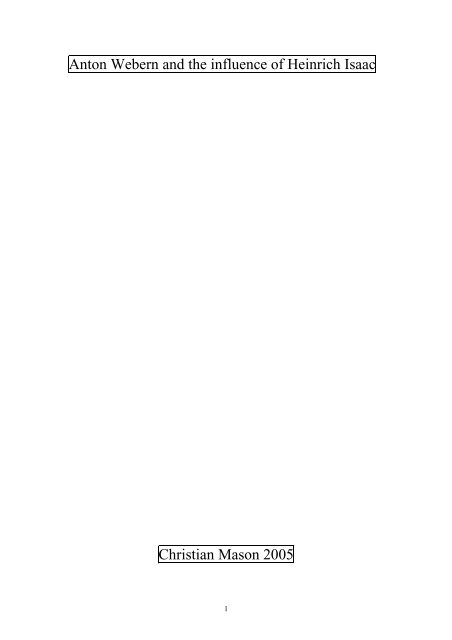
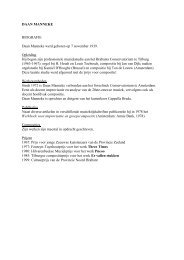
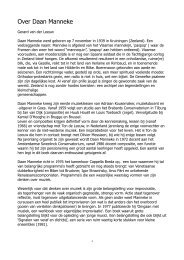
![Schubert, Winterreise: Einsamkeit [PDF] - bestmusicteacher.com](https://img.yumpu.com/21166489/1/190x135/schubert-winterreise-einsamkeit-pdf-bestmusicteachercom.jpg?quality=85)
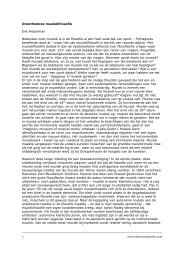
![Schubert, Winterreise: Die Nebensonnen [PDF] - Bestmusicteacher ...](https://img.yumpu.com/20295219/1/190x135/schubert-winterreise-die-nebensonnen-pdf-bestmusicteacher-.jpg?quality=85)
